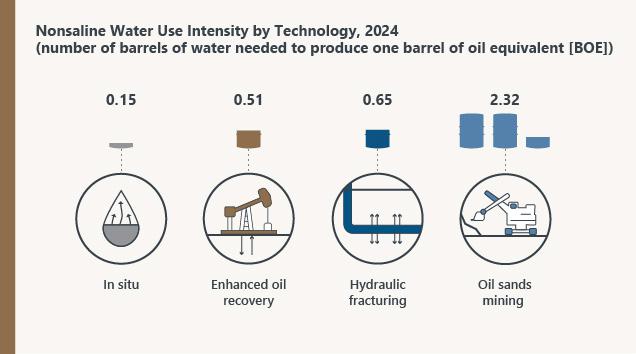October 2025
Energy companies use water throughout the life cycles of their projects and activities. It's our job to ensure Alberta's energy industry uses water resources responsibly and identify areas for improvement.
Our Alberta Water Use Performance Report shows how water is allocated and used to recover oil, gas, and oil sands resources. This annual report is part of our industry performance program, which measures, evaluates, and reports on the energy development activities we regulate.
Our report provides information about water allocation and use for four oil and gas extraction technologies:
- oil sands mining
- in situ oil sands
- enhanced oil recovery
- hydraulic fracturing
Because the volume of water used for conventional oil and gas drilling and operations is typically quite small, it is not discussed in the report. Water used for refining and processing activities is also not included in the report.
2024 Report Highlights
- Only 7% of the nonsaline water available in Alberta was allocated for use in 2024.
- 12% of all nonsaline water allocated in the province was allocated for Alberta’s energy industry. Alberta's energy industry used 28% of their nonsaline water allocation.
- 81% of water used by the oil and gas industry was recycled water, 18% nonsaline, and 1% alternative water.
- Nonsaline water use intensity across the energy industry decreased by 13% since 2013.
- The oil sands mining sector drives water use intensity and accounts for 83% of the nonsaline water used by the energy industry.
- Nonsaline water use intensity in the oil sands mining sector was 2.32 barrels (bbl) per barrel of oil equivalent (BOE), a 19% decrease since 2013.
- In 2024, 78% of the water used for oil sands mining was recycled water, and 9% was make-up water from surface runoff and groundwater. Using water from these sources reduces withdrawals from the Athabasca River, which accounts for 13% of the water used.
- Nonsaline water use intensity for hydraulic fracturing was 0.65 bbl/BOE. Hydraulically fractured wells use water during the fracturing process, but usually none after the well starts producing hydrocarbons. Consequently, water use intensity for hydraulic fracturing is high during the first 12 months of production, falling to 0.08 bbl/BOE after ten years of production for the average hydraulically fractured well.
- Nonsaline water use intensity for enhanced oil recovery was 0.51 bbl/BOE.
- Nonsaline water use intensity for in situ oil sands operations was 0.15 bbl/BOE.
The figure below shows the nonsaline water use intensity for the extraction technologies discussed.

2024 Data
Data for this report are available in 2024 water use data [xlsx].
Find out how water is allocated in the Water Availability and Allocation section.


